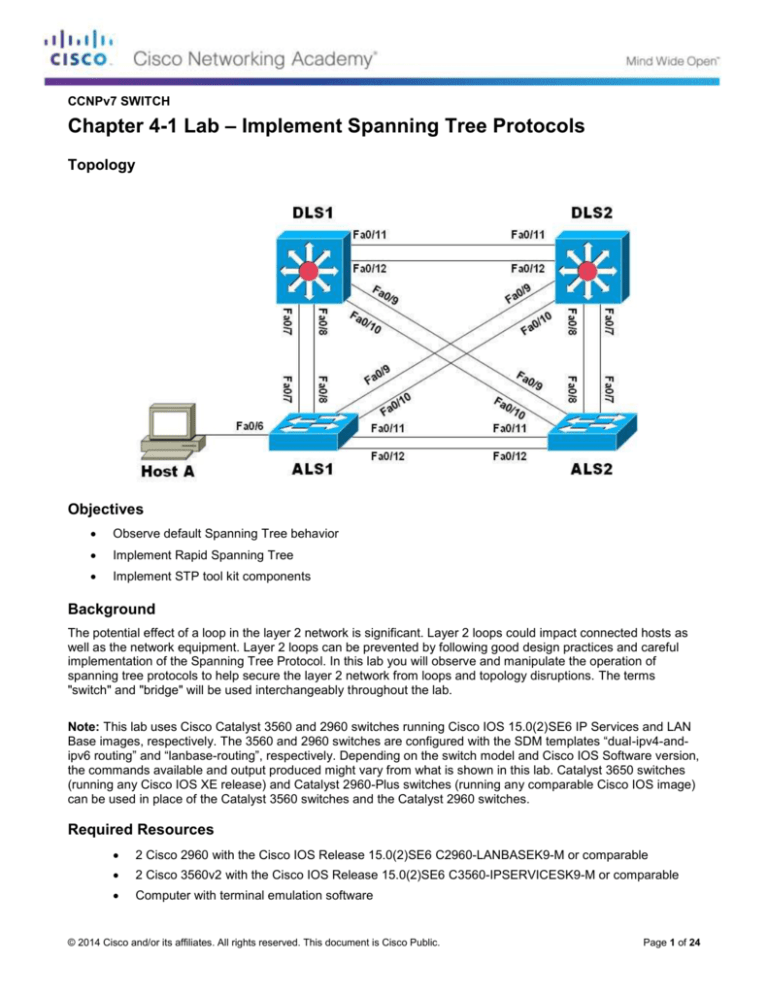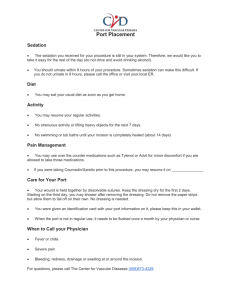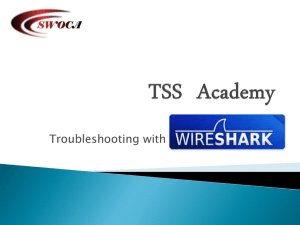
CCNPv7 SWITCH
Chapter 4-1 Lab – Implement Spanning Tree Protocols
Topology
Objectives
Observe default Spanning Tree behavior
Implement Rapid Spanning Tree
Implement STP tool kit components
Background
The potential effect of a loop in the layer 2 network is significant. Layer 2 loops could impact connected hosts as
well as the network equipment. Layer 2 loops can be prevented by following good design practices and careful
implementation of the Spanning Tree Protocol. In this lab you will observe and manipulate the operation of
spanning tree protocols to help secure the layer 2 network from loops and topology disruptions. The terms
"switch" and "bridge" will be used interchangeably throughout the lab.
Note: This lab uses Cisco Catalyst 3560 and 2960 switches running Cisco IOS 15.0(2)SE6 IP Services and LAN
Base images, respectively. The 3560 and 2960 switches are configured with the SDM templates “dual-ipv4-andipv6 routing” and “lanbase-routing”, respectively. Depending on the switch model and Cisco IOS Software version,
the commands available and output produced might vary from what is shown in this lab. Catalyst 3650 switches
(running any Cisco IOS XE release) and Catalyst 2960-Plus switches (running any comparable Cisco IOS image)
can be used in place of the Catalyst 3560 switches and the Catalyst 2960 switches.
Required Resources
2 Cisco 2960 with the Cisco IOS Release 15.0(2)SE6 C2960-LANBASEK9-M or comparable
2 Cisco 3560v2 with the Cisco IOS Release 15.0(2)SE6 C3560-IPSERVICESK9-M or comparable
Computer with terminal emulation software
© 2014 Cisco and/or its affiliates. All rights reserved. This document is Cisco Public.
Page 1 of 24
CCNPv7 SWITCH: Lab 4-1 – Implement Spanning Tree Protocols
Ethernet and console cables
1 Windows 7 PC with Wireshark, TCPDump, or another comparable packet capture utility installed
Part 1: Observe default Spanning Tree behavior
Step 1: Load base config and configure trunks
Use the reset.tcl script you created in Lab 1 “Preparing the Switch” to set your switches up for this lab.
Then load the file BASE.CFG into the running-config with the command copy flash:BASE.CFG
running-config.
Perform this step on all four switches. An example from DLS1:
DLS1# tclsh reset.tcl
Erasing the nvram filesystem will remove all configuration files! Continue? [confirm]
[OK]
Erase of nvram: complete
Reloading the switch in 1 minute, type reload cancel to halt
Proceed with reload? [confirm]
*Mar 7 18:41:40.403: %SYS-7-NV_BLOCK_INIT: Initialized the geometry of nvram
*Mar 7 18:41:41.141: %SYS-5-RELOAD: Reload requested by console. Reload Reason:
Reload command.
<switch reloads - output omitted>
Would you like to enter the initial configuration dialog? [yes/no]: n
Switch> en
*Mar 1 00:01:30.915: %LINK-5-CHANGED: Interface Vlan1, changed state to
administratively down
Switch# copy BASE.CFG running-config
Destination filename [running-config]?
184 bytes copied in 0.310 secs (594 bytes/sec)
DLS1#
Next, enable interfaces F0/7 through F0/12 as 802.1Q trunk ports. Perform this step on all four switches. An
example from DLS1:
DLS1# conf t
Enter configuration commands, one
DLS1(config)# int ran f0/7-12
DLS1(config-if-range)# switchport
DLS1(config-if-range)# switchport
DLS1(config-if-range)# switchport
DLS1(config-if-range)# switchport
DLS1(config-if-range)# switchport
DLS1(config-if-range)# no shut
DLS1(config-if-range)# exit
DLS1(config)#
per line.
End with CNTL/Z.
trunk encap dot1q
trunk native vlan 666
trunk allowed vlan except 1,999
mode trunk
nonegotiate
© 2014 Cisco and/or its affiliates. All rights reserved. This document is Cisco Public.
Page 2 of 24
CCNPv7 SWITCH: Lab 4-1 – Implement Spanning Tree Protocols
Finally, configure all four switches as VTP version 3 servers in domain SWLAB with no password. An
example from DLS1:
DLS1(config)# vtp mode server
Setting device to VTP Server mode for VLANS.
DLS1(config)# vtp domain SWLAB
Changing VTP domain name from NULL to SWLAB
DLS1(config)# vtp version 3
DLS1(config)#
Step 2: Configure VLANs
Configure DLS1 as the VTP Primary Server for VLANs, and then create VLANs. The VLAN database will
propagate to the other switches in the network.
DLS1# vtp primary vlan
This system is becoming primary server for feature vlan
No conflicting VTP3 devices found.
Do you want to continue? [confirm]
DLS1#
*Mar 1 01:35:22.917: %SW_VLAN-4-VTP_PRIMARY_SERVER_CHG: e840.406f.7280 has become the
primary server for the VLAN VTP feature
DLS1# conf t
Enter configuration commands, one per line. End with CNTL/Z.
DLS1(config)# vlan 99
DLS1(config-vlan)# name MANAGEMENT
DLS1(config-vlan)# vlan 100
DLS1(config-vlan)# name SERVERS
DLS1(config-vlan)# vlan 110
DLS1(config-vlan)# name GUEST
DLS1(config-vlan)# vlan 120
DLS1(config-vlan)# name OFFICE
DLS1(config-vlan)# vlan 999
DLS1(config-vlan)# name PARKING_LOT
DLS1(config-vlan)# state suspend
DLS1(config-vlan)# vlan 666
DLS1(config-vlan)# name NATIVE_DO_NOT_USE
DLS1(config-vlan)# exit
DLS1(config)#
ALS2# show vtp status
VTP Version capable
VTP version running
VTP Domain Name
VTP Pruning Mode
VTP Traps Generation
Device ID
:
:
:
:
:
:
1 to 3
3
SWLAB
Disabled
Disabled
0017.95cf.1680
Feature VLAN:
© 2014 Cisco and/or its affiliates. All rights reserved. This document is Cisco Public.
Page 3 of 24
CCNPv7 SWITCH: Lab 4-1 – Implement Spanning Tree Protocols
-------------VTP Operating Mode
Number of existing VLANs
Number of existing extended VLANs
Maximum VLANs supported locally
Configuration Revision
Primary ID
Primary Description
MD5 digest
:
:
:
:
:
:
:
:
Server
11
0
255
3
e840.406f.7280
DLS1
0x1B 0x3A 0xCF 0xEF 0xD4 0xBB 0xCD 0xD8
0xF9 0x60 0x75 0xC9 0x73 0x01 0x28 0x94
<output omitted>
ALS2# show vlan brief | i active
1
default
99
MANAGEMENT
100 SERVERS
110 GUEST
120 OFFICE
666 NATIVE_DO_NOT_USE
ALS2#
active
active
active
active
active
active
Fa0/1, Fa0/2, Fa0/3, Fa0/4
Step 3: Identify and modify the root bridge
Use the show span root command on all of the switches to find the root switch for all of the VLANs. Note:
Your results may vary from the examples.
DLS1# show span root
Vlan
---------------VLAN0099
VLAN0100
VLAN0110
VLAN0120
VLAN0666
DLS1#
Root
Hello Max Fwd
Root ID
Cost
Time Age Dly
-------------------- --------- ----- --- --32867 0017.95cf.1680
19
2
20 15
32868 0017.95cf.1680
19
2
20 15
32878 0017.95cf.1680
19
2
20 15
32888 0017.95cf.1680
19
2
20 15
33434 0017.95cf.1680
19
2
20 15
Root Port
-----------Fa0/9
Fa0/9
Fa0/9
Fa0/9
Fa0/9
ALS2# show span root
Vlan
---------------VLAN0099
VLAN0100
VLAN0110
VLAN0120
VLAN0666
ALS2#
Root ID
-------------------32867 0017.95cf.1680
32868 0017.95cf.1680
32878 0017.95cf.1680
32888 0017.95cf.1680
33434 0017.95cf.1680
Root
Hello Max Fwd
Cost
Time Age Dly
--------- ----- --- --0
2
20 15
0
2
20 15
0
2
20 15
0
2
20 15
0
2
20 15
Root Port
------------
Compare the output of the show span command on all of the switches; why did the current root get elected?
© 2014 Cisco and/or its affiliates. All rights reserved. This document is Cisco Public.
Page 4 of 24
CCNPv7 SWITCH: Lab 4-1 – Implement Spanning Tree Protocols
DLS2#show span vlan 99
VLAN0099
Spanning tree enabled protocol ieee
Root ID
Priority
32867
Address
0017.95cf.1680
Cost
19
Port
9 (FastEthernet0/7)
Hello Time
2 sec Max Age 20 sec
Bridge ID
Priority
Address
Hello Time
Aging Time
Interface
------------------Fa0/7
Fa0/8
Fa0/9
Fa0/10
Fa0/11
Fa0/12
Role
---Root
Altn
Altn
Altn
Desg
Desg
Forward Delay 15 sec
32867 (priority 32768 sys-id-ext 99)
e840.406f.6e00
2 sec Max Age 20 sec Forward Delay 15 sec
300 sec
Sts
--FWD
BLK
BLK
BLK
FWD
FWD
Cost
--------19
19
19
19
19
19
Prio.Nbr
-------128.9
128.10
128.11
128.12
128.13
128.14
Type
-------------------------------P2p
P2p
P2p
P2p
P2p
P2p
The current root bridge was elected based on the lowest Bridge ID (consisting of the Priority, extended
system ID equal to the VLAN ID, and base MAC address values). In the output above, the root’s MAC is
0017.95cf.1680; the local bridge MAC is e840.406f.6e00.
With the priority and extended system IDs being identical, the root bridge's MAC is numerically smaller than
the local bridge’s MAC. The end result is that in a completely unconfigured network, one single switch will be
elected as the root bridge. The resulting choice of switch may or may not be desirable.
There are two basic ways to manipulate the configuration to control the location of the root bridge.
The spanning-tree vlan vlan-id priority value command can be used to manually set a
priority value
The spanning-tree vlan vlan-id root { primary | secondary } command can be
used to automatically set a priority value.
The difference between the two - the priority command will set a specific number (multiple of 4096) as the
priority, while the root primary command will set the local bridge's priority to 24,576 (if the local bridge
MAC is lower than the current root bridge's MAC) or 4096 lower than the current root's priority (if the local
bridge MAC is higher than the current root bridge's MAC).
The logic behind this operation is straight-forward: the root primary command tries to lower the priority
only as much as is needed to win the root election, while leaving priorities between 24576 and the default
32768 for use by secondary bridges. The command always takes the entire Bridge ID into account when
computing the resulting priority value.
The spanning-tree vlan vlan-id root secondary command will statically set the local bridge’s
priority to 28,672. In an otherwise unconfigured network where all switch priorities default to 32,768, the root
primary command will set the priority on the switch to 24,576 (two “steps” lower than the default priority)
© 2014 Cisco and/or its affiliates. All rights reserved. This document is Cisco Public.
Page 5 of 24
CCNPv7 SWITCH: Lab 4-1 – Implement Spanning Tree Protocols
while the root secondary command will set the priority on the secondary root to the 28,672 (one “step”
lower than the default priority).
Modify DLS1 and DLS2 so that DLS 1 is elected the primary root bridge for VLANs 99 and 100 and DLS2 is
elected the primary root bridge for VLAN 110 and 120. DLS1 should be elected as the secondary root bridge
for VLAN 110 and 120, and DLS2 should be elected as the secondary root bridge for VLANs 99, and 100.
You will need to make configuration changes on both DLS1 and DLS2. An example from DLS1:
DLS1# conf t
Enter configuration commands, one per line. End with CNTL/Z.
DLS1(config)# spanning-tree vlan 99,100 root primary
DLS1(config)# spanning-tree vlan 110,120 root secondary
DLS1(config)# exit
DLS1#
Verification from DLS1:
DLS1# show spanning-tree root
Vlan
---------------VLAN0099
VLAN0100
VLAN0110
VLAN0120
VLAN0666
DLS1#
Root
Hello Max Fwd
Root ID
Cost
Time Age Dly
-------------------- --------- ----- --- --24675 e840.406f.7280
0
2
20 15
24676 e840.406f.7280
0
2
20 15
24686 e840.406f.6e00
19
2
20 15
24696 e840.406f.6e00
19
2
20 15
33434 0017.95cf.1680
19
2
20 15
Root Port
------------
Fa0/11
Fa0/11
Fa0/9
The show spanning-tree bridge command also provides detailed information about the current
configuration of the local bridge:
DLS1# show spanning-tree bridge ?
address
Mac address of this bridge
detail
Detailed of the status and configuration
forward-time Forward delay interval
hello-time
Hello time
id
Spanning tree bridge identifier
max-age
Max age
priority
Bridge priority of this bridge
protocol
Spanning tree protocol
|
Output modifiers
<cr>
© 2014 Cisco and/or its affiliates. All rights reserved. This document is Cisco Public.
Page 6 of 24
CCNPv7 SWITCH: Lab 4-1 – Implement Spanning Tree Protocols
DLS1# show spanning-tree bridge
Vlan
---------------VLAN0099
VLAN0100
VLAN0110
VLAN0120
VLAN0666
DLS1#
Hello
Bridge ID
Time
--------------------------------- ----24675 (24576, 99) e840.406f.7280
2
24676 (24576, 100) e840.406f.7280
2
28782 (28672, 110) e840.406f.7280
2
28792 (28672, 120) e840.406f.7280
2
33434 (32768, 666) e840.406f.7280
2
Max
Age
--20
20
20
20
20
Fwd
Dly
--15
15
15
15
15
Protocol
-------ieee
ieee
ieee
ieee
ieee
Step 4: Manipulate port and path costs
As the network is implemented right now, there are two paths between each directly connected switch. As the
Root Port is elected, path and port costs are evaluated to determine the shortest path to the root bridge.
In the case where there are multiple equal cost paths to the root bridge, additional attributes must be
evaluated. In our case, the lower interface number (for example, F0/11) is chosen as the Root Port, and the
higher interface number (for example, F0/12) is put into a spanning tree Blocking state.
You can see which ports are blocked with the show spanning-tree vlan-id command or the show
spanning-tree blockedports command. For now examine VLAN 110 on DLS1.
DLS1# show spanning-tree vlan 110
VLAN0110
Spanning tree enabled protocol ieee
Root ID
Priority
24686
Address
e840.406f.6e00
Cost
19
Port
13 (FastEthernet0/11)
Hello Time
2 sec Max Age 20 sec
Bridge ID
Priority
Address
Hello Time
Aging Time
Interface
------------------Fa0/7
Fa0/8
Fa0/9
Fa0/10
Fa0/11
Fa0/12
Role
---Desg
Desg
Desg
Desg
Root
Altn
Forward Delay 15 sec
28782 (priority 28672 sys-id-ext 110)
e840.406f.7280
2 sec Max Age 20 sec Forward Delay 15 sec
300 sec
Sts
--FWD
FWD
FWD
FWD
FWD
BLK
Cost
--------19
19
19
19
19
19
Prio.Nbr
-------128.9
128.10
128.11
128.12
128.13
128.14
Type
-------------------------------P2p
P2p
P2p
P2p
P2p
P2p
© 2014 Cisco and/or its affiliates. All rights reserved. This document is Cisco Public.
Page 7 of 24
CCNPv7 SWITCH: Lab 4-1 – Implement Spanning Tree Protocols
DLS1# show spanning-tree blockedports
Name
-------------------VLAN0110
VLAN0120
VLAN0666
Blocked Interfaces List
-----------------------------------Fa0/12
Fa0/12
Fa0/7, Fa0/8, Fa0/10, Fa0/11, Fa0/12
Number of blocked ports (segments) in the system : 7
As you can see, VLAN 110 has its Root Port on Fa0/11 and Fa0/12 is an Alternate Blocking Port. Note that
despite the switch not yet running Rapid STP, it recognizes the port roles as known by RSTP.
It is possible to manipulate which port becomes the Root Port on non-root bridges by manipulating the port
cost value, or by changing the port priority value. Remember that this change could have an impact on
downstream switches as well. For this example, we will examine both options.
Note: The changes you are about to implement are considered topology changes and could have a significant
impact on the overall structure of the spanning tree in your switch network. Do not make these changes in a
production network without careful planning and prior coordination.
The first change you will make will influence the Root Port election based on a change to the port cost. We
will further examine the impact of the changes to downstream switches.
To do this, issue the shutdown command on interfaces Fa0/9 and Fa0/10 on DLS1 and DLS2. Example from
DLS1:
DLS1# conf t
Enter configuration commands, one per line.
DLS1(config)# int ran f0/9-10
DLS1(config-if-range)# shut
DLS1(config-if-range)# exit
DLS1(config)#
End with CNTL/Z.
Then, examine the VLAN 110 root values on ALS1:
ALS1# show span root
Vlan
---------------VLAN0099
VLAN0100
VLAN0110
Root
Hello Max Fwd
Root ID
Cost
Time Age Dly
-------------------- --------- ----- --- --24675 e840.406f.7280
19
2
20 15
24676 e840.406f.7280
19
2
20 15
24686 e840.406f.6e00
38
2
20 15
© 2014 Cisco and/or its affiliates. All rights reserved. This document is Cisco Public.
Root Port
-----------Fa0/7
Fa0/7
Fa0/7
Page 8 of 24
CCNPv7 SWITCH: Lab 4-1 – Implement Spanning Tree Protocols
VLAN0120
VLAN0666
ALS1#
24696 e840.406f.6e00
33434 0017.95cf.1680
38
19
2
2
20
20
15
15
Fa0/7
Fa0/11
The election of the Root Port is based on the lowest total path cost to the root bridge. The root path cost is a
sum of all of the Root Port costs between the local bridge and the root bridge. If the total path cost to the root
bridge is the same over multiple ports, then the port towards the neighbor switch that has the lowest Bridge ID
is chosen as the Root Port.
If the local bridge has multiple connections to a neighbor bridge that is in the lowest-cost path, BDPUs sent
from that neighbor are examined and the BPDU containing the lowest sending Port-ID is chosen as the Root
Port. In this case the term "sending" refers to the switch and its port that forwarded the BPDU.
Notice in the output above that the root bridge for VLAN110 is reachable from ALS1 via Fa0/7 with a total root
path cost of 38 (19 for the Fa0/7 trunk between ALS1 and DLS1, and 19 for the trunk between DLS1 and
DLS2).
On ALS2, change the spanning tree cost on interface Fa0/7 to 12.
ALS2(config)# int f0/7
ALS2(config-if)# spanning-tree cost 12
ALS2(config-if)# exit
ALS2(config)#
Now go back to ALS1 and see the impact:
ALS1# show span root
Vlan
---------------VLAN0099
VLAN0100
VLAN0110
VLAN0120
VLAN0666
ALS1#
Root
Hello Max Fwd
Root ID
Cost
Time Age Dly
-------------------- --------- ----- --- --24675 e840.406f.7280
19
2
20 15
24676 e840.406f.7280
19
2
20 15
24686 e840.406f.6e00
31
2
20 15
24696 e840.406f.6e00
31
2
20 15
33434 0017.95cf.1680
19
2
20 15
Root Port
-----------Fa0/7
Fa0/7
Fa0/11
Fa0/11
Fa0/11
ALS1's Root Port changed to F0/11, and the path cost to the Root Bridge changed to 31 (19 + 12).
The change you just made on ALS2 did not impact the Root Port from its perspective; it is still Fa0/7.
Next you will use port priority to modify which port is selected as the Root Port. For this exercise, we will focus
on VLAN 100.
On DLS1, use show span vlan 100 to see what the priorities are (default to 128)
© 2014 Cisco and/or its affiliates. All rights reserved. This document is Cisco Public.
Page 9 of 24
CCNPv7 SWITCH: Lab 4-1 – Implement Spanning Tree Protocols
DLS1# show span vlan 100
VLAN0100
Spanning tree enabled protocol ieee
Root ID
Priority
24676
Address
e840.406f.7280
This bridge is the root
Hello Time
2 sec Max Age 20 sec
Bridge ID
Priority
Address
Hello Time
Aging Time
Interface
------------------Fa0/7
Fa0/8
Fa0/11
Fa0/12
Role
---Desg
Desg
Desg
Desg
Forward Delay 15 sec
24676 (priority 24576 sys-id-ext 100)
e840.406f.7280
2 sec Max Age 20 sec Forward Delay 15 sec
300 sec
Sts
--FWD
FWD
FWD
FWD
Cost
--------19
19
19
19
Prio.Nbr
-------128.9
128.10
128.13
128.14
Type
-------------------------------P2p
P2p
P2p
P2p
In the output above, focus on interface Fa0/7. Notice that its Port ID is made up of two values, labeled as Prio
(Priority) and Nbr (Number): The priority number (128) and the port number (9).
The port number is not necessarily equal to the interface ID. On the 3560s used for creating this lab, port
numbers 1 and 2 are assigned to G0/1 and G0/2 respectively, whereas on the 2960s G0/1 and G0/2 area
assigned the port numbers 25 and 26. A switch may use any port number for STP purposed as long as they
are unique for each port on the switch.
The port priority can be any value between 0 and 240, in increments of 16 (older switches may allow setting
the priority in different increments).
Next, examine ALS1 to find the root port for VLAN 100:
ALS1# show span root | i VLAN0100
VLAN0100
24676 e840.406f.7280
ALS1#
19
2
20
15
Fa0/7
On DLS1, change the port priority value of Fa0/8 to 112:
DLS1(config)# int f0/8
DLS1(config-if)# spanning-tree port-priority 112
DLS1(config-if)# exit
And then examine the impact on ALS1:
ALS1# show span root | i VLAN0100
© 2014 Cisco and/or its affiliates. All rights reserved. This document is Cisco Public.
Page 10 of 24
CCNPv7 SWITCH: Lab 4-1 – Implement Spanning Tree Protocols
VLAN0100
24676 e840.406f.7280
19
2
20
15
Fa0/8
ALS1# show span vlan 100
VLAN0100
Spanning tree enabled protocol ieee
Root ID
Priority
24676
Address
e840.406f.7280
Cost
19
Port
8 (FastEthernet0/8)
Hello Time
2 sec Max Age 20 sec
Bridge ID
Priority
Address
Hello Time
Aging Time
Interface
------------------Fa0/7
Fa0/8
Fa0/11
Fa0/12
Role
---Altn
Root
Desg
Desg
Forward Delay 15 sec
32868 (priority 32768 sys-id-ext 100)
0017.95d1.8b80
2 sec Max Age 20 sec Forward Delay 15 sec
15 sec
Sts
--BLK
FWD
FWD
FWD
Cost
--------19
19
19
19
Prio.Nbr
-------128.7
128.8
128.11
128.12
Type
-------------------------------P2p
P2p
P2p
P2p
Notice that the priority value at ALS1 doesn't change, but the Root Port did, based on DLS1's advertised port
priorities.
Step 5: Examine Reconvergence Time
Use the debug spanning-tree events command on DLS1 and watch how long reconvergence takes
when interface Fa0/11 on DLS1 is shut down (Fa0/11 is DLS1’s Root Port for VLAN 110). The output below
has been manually filtered for VLAN 110 related messages only:
DLS1# debug span eve
Spanning Tree event debugging is on
DLS1# conf t
Enter configuration commands, one per line. End with CNTL/Z.
DLS1(config)# int f0/11
DLS1(config-if)# shut
DLS1(config-if)#
*Mar 1 00:30:48.312: STP: VLAN0110 new root port Fa0/12, cost 19
*Mar 1 00:30:48.320: STP: VLAN0110 Fa0/12 -> listening
*Mar 1 00:30:48.320: STP[110]: Generating TC trap for port FastEthernet0/11
*Mar 1 00:30:50.300: %LINK-5-CHANGED: Interface FastEthernet0/11, changed state to
administratively down
DLS1(config-if)#
*Mar 1 00:30:50.317: STP: VLAN0110 sent Topology Change Notice on Fa0/12
DLS1(config-if)#
*Mar 1 00:30:51.307: %LINEPROTO-5-UPDOWN: Line protocol on Interface
FastEthernet0/11, changed state to down
DLS1(config-if)#
© 2014 Cisco and/or its affiliates. All rights reserved. This document is Cisco Public.
Page 11 of 24
CCNPv7 SWITCH: Lab 4-1 – Implement Spanning Tree Protocols
*Mar 1 00:31:03.327: STP: VLAN0110 Fa0/12 -> learning
DLS1(config-if)#
*Mar 1 00:31:18.335: STP[110]: Generating TC trap for port FastEthernet0/12
*Mar 1 00:31:18.335: STP: VLAN0110 sent Topology Change Notice on Fa0/12
*Mar 1 00:31:18.335: STP: VLAN0110 Fa0/12 -> forwarding
DLS1(config-if)#do sho span vlan 110
VLAN0110
Spanning tree enabled protocol ieee
Root ID
Priority
24686
Address
e840.406f.6e00
Cost
19
Port
14 (FastEthernet0/12)
Hello Time
2 sec Max Age 20 sec
Bridge ID
Priority
Address
Hello Time
Aging Time
Interface
------------------Fa0/7
Fa0/8
Fa0/12
Role
---Desg
Desg
Root
Forward Delay 15 sec
28782 (priority 28672 sys-id-ext 110)
e840.406f.7280
2 sec Max Age 20 sec Forward Delay 15 sec
300 sec
Sts
--FWD
FWD
FWD
Cost
--------19
19
19
Prio.Nbr
-------128.9
112.10
128.14
Type
-------------------------------P2p
P2p
P2p
As you can see from the timestamps, it took a full 30 seconds for PVST to settle on Fa0/12 as the root port
and move to the Forwarding state on the Designated Ports. When Fa0/11 is reactivated:
DLS1(config-if)# no shut
*Mar 1 00:32:12.382: set portid: VLAN0110 Fa0/11: new port id 800D
*Mar 1 00:32:12.382: STP: VLAN0110 Fa0/11 -> listening
*Mar 1 00:32:12.601: STP: VLAN0110 new root port Fa0/11, cost 19
*Mar 1 00:32:12.601: STP: VLAN0110 sent Topology Change Notice on Fa0/11
*Mar 1 00:32:12.601: STP[110]: Generating TC trap for port FastEthernet0/12
*Mar 1 00:32:12.601: STP: VLAN0110 Fa0/12 -> blocking
*Mar 1 00:32:12.609: %LINK-3-UPDOWN: Interface FastEthernet0/11, changed state to up
*Mar 1 00:32:13.616: %LINEPROTO-5-UPDOWN: Line protocol on Interface
FastEthernet0/11, changed state to up
*Mar 1 00:32:27.390: STP: VLAN0110 Fa0/11 -> learning
*Mar 1 00:32:42.397: STP[110]: Generating TC trap for port FastEthernet0/11
*Mar 1 00:32:42.397: STP: VLAN0110 sent Topology Change Notice on Fa0/11
*Mar 1 00:32:42.397: STP: VLAN0110 Fa0/11 -> forwarding
DLS1(config-if)#do sho span vlan 110
VLAN0110
Spanning tree enabled protocol ieee
Root ID
Priority
24686
Address
e840.406f.6e00
© 2014 Cisco and/or its affiliates. All rights reserved. This document is Cisco Public.
Page 12 of 24
CCNPv7 SWITCH: Lab 4-1 – Implement Spanning Tree Protocols
Bridge ID
Cost
Port
Hello Time
19
13 (FastEthernet0/11)
2 sec Max Age 20 sec
Priority
Address
Hello Time
Aging Time
28782 (priority 28672 sys-id-ext 110)
e840.406f.7280
2 sec Max Age 20 sec Forward Delay 15 sec
15 sec
Interface
------------------Fa0/7
Fa0/8
Fa0/11
Fa0/12
Role
---Desg
Desg
Root
Altn
Sts
--FWD
FWD
FWD
BLK
Cost
--------19
19
19
19
Prio.Nbr
-------128.9
112.10
128.13
128.14
Forward Delay 15 sec
Type
-------------------------------P2p
P2p
P2p
P2p
The reconvergence process took another full 30 seconds.
Part 2: Implement Rapid Spanning Tree
By default Cisco switches are running Per-VLAN Spanning Tree, which is a Cisco-proprietary protocol derived
from the IEEE 802.1D standard.
DLS1# show span detail
VLAN0099 is executing the ieee compatible Spanning Tree protocol
<output omitted>
The running configuration shows you the protocol being used
DLS1# show run | inc spanning-tree mode
spanning-tree mode pvst
DLS1#
The issue with PVST is that its convergence is quite slow. The time for the transition between port states is
called forward_delay and by default, it is 15 seconds. In addition, the time until a BPDU stored on a port
expires is called max_age and is 20 seconds by default. Depending on the nature of a topological change,
STP requires between 30 and 50 seconds to converge on a new loop-free topology.
Rapid Spanning Tree significantly reduces the time it takes to go from the Discarding (PVST: Blocking) to the
Forwarding state.
Configure Rapid Spanning Tree Protocol on DLS1. Use the clear spanning-tree detectedprotocols privileged EXEC command to flush any stored PVST information.
DLS1# conf t
DLS1(config)# spanning-tree mode rapid-pvst
DLS1(config)# end
DLS1#clear spanning-tree detected-protocols
© 2014 Cisco and/or its affiliates. All rights reserved. This document is Cisco Public.
Page 13 of 24
CCNPv7 SWITCH: Lab 4-1 – Implement Spanning Tree Protocols
DLS1#
Then verify the protocol. Use the show span vlan 110 command:
DLS1# show span vlan 120
VLAN0120
Spanning tree enabled protocol rstp
Root ID
Priority
24696
Address
e840.406f.6e00
Cost
19
Port
13 (FastEthernet0/11)
Hello Time
2 sec Max Age 20 sec
Bridge ID
Priority
Address
Hello Time
Aging Time
Interface
------------------Fa0/7
Fa0/8
Fa0/11
Fa0/12
Role
---Desg
Desg
Root
Altn
Forward Delay 15 sec
28792 (priority 28672 sys-id-ext 120)
e840.406f.7280
2 sec Max Age 20 sec Forward Delay 15 sec
300 sec
Sts
--FWD
FWD
FWD
BLK
Cost
--------19
19
19
19
Prio.Nbr
-------128.9
112.10
128.13
128.14
Type
-------------------------------P2p Peer(STP)
P2p Peer(STP)
P2p Peer(STP)
P2p Peer(STP)
Take note of the Type field in the output. All of the other switches are still running PVST, which is noted here
by the entry Peer(STP).
Configure the rest of the switches to use Rapid Spanning Tree Protocol, then verify the protocol is running. An
example from DLS2:
DLS2# show span vlan 99
VLAN0099
Spanning tree enabled protocol rstp
To examine the impact of Rapid Spanning Tree on convergence time, use the debug spanning-tree
events command on DLS1 and watch how long reconvergence takes when interface Fa0/11 on DLS1 is
shut down (Fa0/11 is DLS1’s Root Port for VLAN 110). The output below has been manually filtered for VLAN
110 related messages only:
DLS1# debug spanning-tree events
Spanning Tree event debugging is on
DLS1# conf t
Enter configuration commands, one per line.
DLS1(config)# int f0/11
DLS1(config-if)# shut
End with CNTL/Z.
© 2014 Cisco and/or its affiliates. All rights reserved. This document is Cisco Public.
Page 14 of 24
CCNPv7 SWITCH: Lab 4-1 – Implement Spanning Tree Protocols
DLS1(config-if)#
*Mar 1 23:57:55.169: RSTP(110): updt roles, root port Fa0/11 going down
*Mar 1 23:57:55.169: RSTP(110): Fa0/12 is now root port
*Mar 1 23:57:55.169: RSTP(110): syncing port Fa0/7
*Mar 1 23:57:55.169: RSTP(110): syncing port Fa0/8
*Mar 1 23:57:55.195: STP[110]: Generating TC trap for port FastEthernet0/12
*Mar 1 23:57:55.228: RSTP(110): transmitting a proposal on Fa0/7
*Mar 1 23:57:55.228: RSTP(110): transmitting a proposal on Fa0/8
*Mar 1 23:57:57.149: %LINK-5-CHANGED: Interface FastEthernet0/11, changed state to
administratively down
*Mar 1 23:57:58.156: %LINEPROTO-5-UPDOWN: Line protocol on Interface
FastEthernet0/11, changed state to down
In the output above, the change of Root Port and synchronization to interfaces Fa0/7 and Fa0/8 took less
than six-tenths of a second
DLS1(config-if)#no shut
DLS1(config-if)#
*Mar 1 23:58:13.163: RSTP(110): initializing port Fa0/11
*Mar 1 23:58:13.163: RSTP(110): Fa0/11 is now designated
*Mar 1 23:58:13.188: RSTP(110): updt roles, received superior bpdu on Fa0/11
*Mar 1 23:58:13.188: RSTP(110): Fa0/11 is now root port
*Mar 1 23:58:13.188: RSTP(110): Fa0/12 blocked by re-root
*Mar 1 23:58:13.188: RSTP(110): syncing port Fa0/7
*Mar 1 23:58:13.188: RSTP(110): syncing port Fa0/8
*Mar 1 23:58:13.188: RSTP(110): synced Fa0/11
*Mar 1 23:58:13.188: RSTP(110): Fa0/12 is now alternate
*Mar 1 23:58:13.188: RSTP(110): transmitting an agreement on Fa0/11 as a response to
a proposal
*Mar 1 23:58:13.197: STP[110]: Generating TC trap for port FastEthernet0/11
*Mar 1 23:58:13.213: RSTP(110): transmitting a proposal on Fa0/7
*Mar 1 23:58:13.213: RSTP(110): transmitting a proposal on Fa0/8
*Mar 1 23:58:13.381: %LINK-3-UPDOWN: Interface FastEthernet0/11, changed state to up
*Mar 1 23:58:14.388: %LINEPROTO-5-UPDOWN: Line protocol on Interface
FastEthernet0/11, changed state to up
In the output above, Fa0/11 is brought back up, and the change of root port and synchronization to interfaces
Fa0/7 and Fa0/8 took one half second. This is a significant improvement from standard spanning tree.
Part 3: Part 3: Implement STP tool kit components
Step 1: Implement and observe PortFast
In both STP and RSTP, a newly connected port must be guaranteed not to create a switching loop before it
can become a Forwarding port. This may take up to 30 seconds. However, such a check is not necessary for
ports connected to end devices that do not perform switching or bridging, such as workstations, network
printers, servers, etc. In RSTP, these ports are called edge ports (ports that connect to other switches in the
© 2014 Cisco and/or its affiliates. All rights reserved. This document is Cisco Public.
Page 15 of 24
CCNPv7 SWITCH: Lab 4-1 – Implement Spanning Tree Protocols
topology are called non-edge ports). Edge ports can safely enter the Forwarding state right after they come
up, because by definition they do not connect to any device capable of forwarding frames.
Cisco developed a feature called PortFast that essentially allows defining a port as an edge port. Any
PortFast enabled port will enter the Forwarding state immediately after coming up, without going through the
intermediary non-forwarding states, saving 30 seconds each time a new connection is made to the port.
PortFast can be used with all STP versions.
Apart from allowing a port to jump into the Forwarding state as soon as it is connected, the concept of an
edge port is extremely important in RSTP and MSTP. Recall that as part of its improvements over legacy
STP, RSTP uses a so-called Proposal/Agreement mechanism to rapidly, yet safely enable a link between
switches if one of the switches has its Root port on that link.
Upon receiving a Proposal on its Root port, a switch puts all its non-edge Designated ports into the Discarding
state, effectively cutting itself off the network and preventing a possible switching loop (this is called the Sync
operation). When this is accomplished, the switch sends an Agreement back out its Root port so that the
upstream Designated port receiving this Agreement can be immediately put into the Forwarding state. The
switch will then start sending its own Proposals on all its non-edge Designated ports that have been just made
Discarding, waiting for Agreements to arrive from downstream switches that would allow these ports to
instantaneously become Forwarding again.
If end devices are connected to ports not configured as edge (that is, PortFast) ports, these ports will become
Discarding during the Sync operation. Because end hosts do not support RSTP and cannot send back an
Agreement, they will be cut off from the network for 30 seconds until the ports reach the Forwarding state
using ordinary timers. As a result, users will experience significant connectivity outages.
Ports configured as edge ports are not affected by the Sync operation and will remain in the Forwarding state
even during the Proposal/Agreement handling. Activating RSTP in a network without properly configuring
ports toward end hosts as edge ports will cause the network to perform possibly even more poorly than with
legacy STP. With RSTP, proper configuration of ports toward end hosts as edge ports is an absolute
necessity. Cisco switches default to all their ports being non-edge ports.
For this lab step to work, Host A must be connected to ALS1’s Fa0/6.
On ALS1, issue the command debug spanning-tree events , then configure F0/6 to be in VLAN 120.
Finally, no shut the interface, shut the interface, and observe the syslog
ALS1# debug spanning-tree events
Spanning Tree event debugging is on
ALS1# conf t
Enter configuration commands, one per line. End with CNTL/Z.
ALS1(config)# int f0/6
ALS1(config-if)# swi mo ac
ALS1(config-if)# swi ac vl 120
ALS1(config-if)# no shut
ALS1(config-if)#
*Mar 2 01:14:43.485: RSTP(120): initializing port Fa0/6
*Mar 2 01:14:43.485: RSTP(120): Fa0/6 is now designated
*Mar 2 01:14:43.493: RSTP(120): transmitting a proposal on Fa0/6
*Mar 2 01:14:43.862: %LINK-3-UPDOWN: Interface FastEthernet0/6, changed state to up
*Mar 2 01:14:44.869: %LINEPROTO-5-UPDOWN: Line protocol on Interface FastEthernet0/6,
changed state to up
*Mar 2 01:14:45.221: RSTP(120): transmitting a proposal on Fa0/6
*Mar 2 01:14:47.234: RSTP(120): transmitting a proposal on Fa0/6
*Mar 2 01:14:49.248: RSTP(120): transmitting a proposal on Fa0/6
© 2014 Cisco and/or its affiliates. All rights reserved. This document is Cisco Public.
Page 16 of 24
CCNPv7 SWITCH: Lab 4-1 – Implement Spanning Tree Protocols
ALS1(config-if)# shut
ALS1(config-if)#
*Mar 2 01:14:57.301: RSTP(120): transmitting a proposal on Fa0/6
*Mar 2 01:15:00.069: %LINK-5-CHANGED: Interface FastEthernet0/6, changed state to
administratively down
*Mar 2 01:15:01.076: %LINEPROTO-5-UPDOWN: Line protocol on Interface FastEthernet0/6,
changed state to down
ALS1(config-if)#
As you can see in the output above, RSTP sees the interface come up, recognizes it as a Designated port,
and starts sending proposals. Now we will add the spanning-tree portfast command to the interface
(the debug is still running):
ALS1(config-if)# spanning-tree portfast
%Warning: portfast should only be enabled on ports connected to a single
host. Connecting hubs, concentrators, switches, bridges, etc... to this
interface when portfast is enabled, can cause temporary bridging loops.
Use with CAUTION
%Portfast has been configured on FastEthernet0/6 but will only
have effect when the interface is in a non-trunking mode.
ALS1(config-if)#
ALS1(config-if)# no shut
ALS1(config-if)#
*Mar 2 01:18:29.096: RSTP(120): initializing port Fa0/6
*Mar 2 01:18:29.096: RSTP(120): Fa0/6 is now designated
*Mar 2 01:18:29.339: %LINK-3-UPDOWN: Interface FastEthernet0/6, changed state to up
*Mar 2 01:18:30.346: %LINEPROTO-5-UPDOWN: Line protocol on Interface FastEthernet0/6,
changed state to up
ALS1(config-if)#
ALS1(config-if)# shut
ALS1(config-if)#
*Mar 2 01:18:38.290: %LINK-5-CHANGED: Interface FastEthernet0/6, changed state to
administratively down
*Mar 2 01:18:39.297: %LINEPROTO-5-UPDOWN: Line protocol on Interface FastEthernet0/6,
changed state to down
ALS1(config-if)# no shut
Disable the debug using the undebug all command.
Notice in output above that with PortFast configured, no proposals are sent out of interface Fa0/6; the port
goes into Forwarding state immediately.
ALS1# show span detail | beg VLAN0120
VLAN0120 is executing the rstp compatible Spanning Tree protocol
<output omitted>
Port 6 (FastEthernet0/6) of VLAN0120 is designated forwarding
© 2014 Cisco and/or its affiliates. All rights reserved. This document is Cisco Public.
Page 17 of 24
CCNPv7 SWITCH: Lab 4-1 – Implement Spanning Tree Protocols
Port path cost 19, Port priority 128, Port Identifier 128.6.
Designated root has priority 24696, address e840.406f.7380
Designated bridge has priority 32888, address 0017.95d1.8b80
Designated port id is 128.6, designated path cost 31
Timers: message age 0, forward delay 0, hold 0
Number of transitions to forwarding state: 1
The port is in the portfast mode
Link type is point-to-point by default
BPDU: sent 11, received 0
Note(1): PortFast should never be enabled on ports connected to another switches. Doing so could cause a
switching loop. RSTP and MSTP have their own mechanisms to put inter-switch links into Forwarding state
rapidly.
Note(2): On trunk interfaces, configuring the spanning-tree portfast command will have no effect. This
is a safety precaution, as trunks are usually connected to other switches. However, in situations like interVLAN routing using a router-on-stick, or when a trunk is being connected to a server that operates on multiple
VLANs simultaneously, it may still be advantageous, and safe, to allow this trunk to be treated as an edge
port and become Forwarding as soon as it is connected. In these cases, you can use the spanning-tree
portfast trunk command on a trunk port to force a switch to treat it as an edge port regardless of its
operating mode. Be absolutely sure that the device connected to such port is not performing Layer2 switching
before using this command.
Note(3): Because the proper configuration of edge ports in RSTP and MSTP is of such great importance for
proper network performance, Cisco also provides the way of globally configuring the PortFast on all access
ports using the spanning-tree portfast default global configuration command. With this command
configured, each port that operates in the access mode will automatically have PortFast enabled. Trunk ports
will not be affected. The logic of this behavior is simple: Usually, trunk ports connect to other switch where
PortFast should never be enabled, while access ports usually connect to end devices.
Step 2: Implement and Observe BPDU Guard
PortFast causes an interface to go into Forwarding state immediately. There is a risk that if two PortFastenabled ports are inadvertently or maliciously connected together, they will both come up as Forwarding
ports, immediately creating a switching loop.
The default, expected behavior of a PortFast port that receives a BPDU is for that port to revert to a normal
spanning-tree non-edge port. There is the potential that the load on a given switch might be too great to
handle the received BPDU properly, prolonging the loop condition.
BPDU Guard adds another layer of protection. Whenever a port protected by BPDU Guard unexpectedly
receives a BPDU, it is immediately put into err-disabled state. Any interfaces can be protected with BPDU
Guard, but its typical use in on PortFast-enabled ports.
BPDU Guard can be configured globally, or on a per-interface basis. If the BPDU Guard is configured on the
global level using the spanning-tree portfast bpduguard default command, the BPDU Guard will
be automatically enabled on all PortFast-enabled ports of the switch. If the BPDU Guard is configured on a
particular interface using the spanning-tree bpduguard enable command, it will apply to this port
unconditionally, regardless of whether it is a PortFast-enabled port.
For this example, we will configure BPDU guard on a trunking interface that is a non-root port on ALS2.
Configuring BPDU Guard on an interface that is intended to be a trunk is not a recommended practice; we are
doing this just to demonstrate the functionality of the tool.
ALS2# conf t
Enter configuration commands, one per line. End with CNTL/Z.
ALS2(config)# int f0/11
ALS2(config-if)# spanning-tree bpduguard enable
© 2014 Cisco and/or its affiliates. All rights reserved. This document is Cisco Public.
Page 18 of 24
CCNPv7 SWITCH: Lab 4-1 – Implement Spanning Tree Protocols
ALS2(config-if)# exit
ALS2(config)#
*Mar 2 01:46:11.223: %SPANTREE-2-BLOCK_BPDUGUARD: Received BPDU on port Fa0/11 with
BPDU Guard enabled. Disabling port.
*Mar 2 01:46:11.232: %PM-4-ERR_DISABLE: bpduguard error detected on Fa0/11, putting
Fa0/11 in err-disable state
*Mar 2 01:46:12.238: %LINEPROTO-5-UPDOWN: Line protocol on Interface
FastEthernet0/11, changed state to down
*Mar 2 01:46:13.253: %LINK-3-UPDOWN: Interface FastEthernet0/11, changed state to
down
As you can see, the interface is almost immediately err-disabled. Revert the configuration settings and issue
the shutdown and no shutdown commands on Fa0/11 to bring it back up.
ALS2(config)# int f0/11
ALS2(config-if)# shut
ALS2(config-if)# no spanning-tree portfast
ALS2(config-if)# spanning-tree bpduguard disable
ALS2(config-if)# no shut
ALS2(config-if)# exit
ALS2(config)#
*Mar 2 01:48:37.277: %LINK-3-UPDOWN: Interface FastEthernet0/11, changed state to up
*Mar 2 01:48:38.284: %LINEPROTO-5-UPDOWN: Line protocol on Interface
FastEthernet0/11, changed state to up
Step 3: Implement and Observe BPDU Filter
Neither PortFast nor BPDU Guard prevents the switch from sending BPDUs on an interface; if such a
behavior is required, BPDU Filter can be used. It can be configured either globally or at a specific interface.
If BPDU Filter is configured on the global level using the spanning-tree portfast bpdufilter
default global configuration command, the BPDU Filter applies only to PortFast-enabled ports. When these
ports come up, they will send up to 11 BPDUs and then stop sending further BPDUs. If the BPDU Filterconfigured interface receives a BPDU at any time, the BPDU Filter and PortFast will be deactivated on that
port and it will become a normal spanning tree interface. As a result, a globally configured BPDU Filter does
not prevent ports from receiving and processing BPDUs; it only attempts to stop sending BPDUs on ports
where most probably, there is no device attached that would be interested in processing them.
Configured at an interface, BPDU Filter causes the port to stop sending and processing received BPDUs
altogether. This can be used, for example, to split a network into two or more independent STP domains,
each having its own root bridge and resulting topology. However, because these domains are no longer
protected against mutual loops by STP, it is the task of the network administrator to make sure that these two
domains are never connected by more than just a single link.
To test this feature, we will run a packet capture utility on Host A connected to ALS1, configure BPDU Filter
on interface Fa0/6, and see that BPDUs stop being transmitted.
Login to Host A, run your packet capture utility and filter the output to show only STP packets. In Wireshark,
the filter bar should look something like this:
© 2014 Cisco and/or its affiliates. All rights reserved. This document is Cisco Public.
Page 19 of 24
CCNPv7 SWITCH: Lab 4-1 – Implement Spanning Tree Protocols
You should see a BPDU being received at your host every 2 seconds.
Now configure BPDU Filter on ALS1 interface Fa0/6
ALS1# conf t
Enter configuration commands, one per line. End with CNTL/Z.
ALS1(config)# int f0/6
ALS1(config-if)# spanning-tree bpdufilter enable
ALS1(config-if)# exit
ALS1(config)#
Clear the Wireshark display filter and observe your packet capture window; you will have stopped receiving
BPDUs.
Step 4: Implement and Observe Root Guard
Root Guard helps prevent a root switch or Root Port takeover. It is configured on the port to be protected. If a
port protected by Root Guard receives a superior BPDU that would normally cause the port to become a Root
port, the BPDU will be discarded and the port will be moved to the Root-Inconsistent state. An STP
inconsistent state differs from the err-disabled state that the port is not disabled entirely; instead, it is only put
into the Blocking (Discarding) state and will be put back into its proper role and state once the cause for its
inconsistent state disappears. With Root Guard, a port will be reinstated into its appropriate role and state
automatically when it stops receiving superior BPDUs.
Note: BPDU Root Guard is a protective mechanism in situations when your network and the network of your
customer need to form a single STP domain, yet you want to have the STP root bridge in your network part
and you do not want your customer to take over this root switch selection, or back up the connectivity in your
network through the customer. In these cases, you would put the Root Guard on ports toward the customer.
However, inside your own network, using Root Guard would actually be harmful. Your network can be
considered trustworthy and there is no rogue root switch to protect against. Using Root Guard in your own
network would cause it to be unable to converge on a new workable spanning tree if any of the primary links
failed, and it would also prevent your network from converging to a secondary root switch if the primary root
switch failed entirely.
© 2014 Cisco and/or its affiliates. All rights reserved. This document is Cisco Public.
Page 20 of 24
CCNPv7 SWITCH: Lab 4-1 – Implement Spanning Tree Protocols
To illustrate the behavior of Root Guard, we will configure it on a designated port on DLS1 for VLAN 100.
DLS1 is the root bridge for VLAN 100, so all trunk ports are designated.
DLS1# show span root
Vlan
---------------VLAN0099
VLAN0100
VLAN0110
VLAN0120
VLAN0666
DLS1#
Root ID
-------------------24675 e840.406f.8b80
24676 e840.406f.8b80
24686 e840.406f.7380
24696 e840.406f.7380
33434 0017.95cf.1680
Root
Hello Max Fwd
Cost
Time Age Dly
--------- ----- --- --0
2
20 15
0
2
20 15
19
2
20 15
19
2
20 15
38
2
20 15
Root Port
------------
Fa0/11
Fa0/11
Fa0/7
Configure Root Guard on DLS1 interface Fa0/7 (you may immediately see errors with another VLAN, like 666.
Ignore these as we are focusing on VLAN 100):
DLS1# conf t
Enter configuration commands, one per line.
DLS1(config)# int f0/7
DLS1(config-if)# spanning-tree guard root
DLS1(config-if)# exit
DLS1(config)#
End with CNTL/Z.
Then go to ALS1 and configure it to be the root for VLAN 100 using the priority 16384
ALS1(config)# spanning-tree vlan 100 priority 16384
Then back at DLS1, check the spanning tree interface status for Fa0/7:
DLS1# show spanning-tree interface f0/7 | inc VLAN0100
VLAN0100
Desg BKN*19
128.9
P2p *ROOT_Inc
DLS1#
This output has two indicators of the issue. First BKN* is short for "BROKEN", and *ROOT_Inc represents the
Root Inconsistent message. A list of all STP inconsistent ports including the reason for their inconsistency can
also be requested with the command show spanning-tree inconsistentports.
DLS1# show spanning-tree inconsistentports
Name
-------------------VLAN0100
VLAN0666
Interface
-----------------------FastEthernet0/7
FastEthernet0/7
Inconsistency
-----------------Root Inconsistent
Root Inconsistent
© 2014 Cisco and/or its affiliates. All rights reserved. This document is Cisco Public.
Page 21 of 24
CCNPv7 SWITCH: Lab 4-1 – Implement Spanning Tree Protocols
Number of inconsistent ports (segments) in the system : 2
DLS1#
To clear this, go back to ALS1 and issue the command no spanning-tree vlan 100 priority
16384. Once you do this, you will see the following SYSLOG message at DLS1, and the interface will
become consistent again.
DLS1#
*Mar 2 03:18:37.041: %SPANTREE-2-ROOTGUARD_UNBLOCK: Root guard unblocking port
FastEthernet0/7 on VLAN0100.
DLS1# show spanning-tree interface f0/7 | inc VLAN0100
VLAN0100
Desg FWD 19
128.9
P2p
DLS1#
For completeness, remove Root Guard from Fa0/7 on DLS1
DLS1# conf t
Enter configuration commands, one per line. End with CNTL/Z.
DLS1(config)# int f0/7
DLS1(config-if)# no spanning-tree guard root
DLS1(config-if)# exit
DLS1(config)#
Step 5: Implement and Observe Loop Guard
The last tool we will demonstrate is Loop Guard. Its job is to prevent Root and Alternate ports from becoming
Designated ports if BPDUs suddenly cease to be received on them
In a normal STP network, all ports receive and process BPDUs, even Blocking (Discarding) ports. This is how
they know that the device at the other end of the link is alive and still superior to them. If a Blocked port stops
receiving these BPDUs, it can only assume that the device on the other side is no longer there and they are
now superior, and should be in Forwarding state for the given segment. An example of when this could occur
is the instance where the Rx fiber in an optical cable becomes disconnected, cut, or connected to a different
port or device than the corresponding Tx fiber, in essence creating an uni-directional link.
This could cause permanent switching loops in the network, so Loop Guard helps to prevent them.
For this example, we will configure Loop Guard on an Alternate port on ALS2, and then stop sending out
BPDUs from the corresponding Designated port on the other end of the link, and observe the behavior.
ALS2# show span vlan 100
VLAN0100
Spanning tree enabled protocol rstp
Root ID
Priority
24676
Address
e840.406f.8b80
Cost
31
Port
7 (FastEthernet0/7)
© 2014 Cisco and/or its affiliates. All rights reserved. This document is Cisco Public.
Page 22 of 24
CCNPv7 SWITCH: Lab 4-1 – Implement Spanning Tree Protocols
Hello Time
Bridge ID
Priority
Address
Hello Time
Aging Time
Interface
------------------Fa0/7
Fa0/8
Fa0/11
Fa0/12
Role
---Root
Altn
Altn
Altn
2 sec
Max Age 20 sec
Forward Delay 15 sec
32868 (priority 32768 sys-id-ext 100)
0017.95cf.1680
2 sec Max Age 20 sec Forward Delay 15 sec
300 sec
Sts
--FWD
BLK
BLK
BLK
Cost
--------12
19
19
19
Prio.Nbr
-------128.7
128.8
128.11
128.12
Type
-------------------------------P2p
P2p
P2p
P2p
Here ALS2 tells us that its path to the root is via Fa0/7 (DLS2), while Fa0/11 and 12 (towards ALS1) are
Alternate ports because the total path cost is more through ALS1 (it is 38, 19+19) than through DLS2 (31,
19+12).
Configure Loop Guard on ALS2s Fa0/11 interface:
ALS2(config)# int f0/11
ALS2(config-if)# spanning-tree guard loop
ALS2(config-if)# exit
Modify the corresponding interface (Fa0/11) on ALS1 to stop sending BPDUs:
ALS1(config)# int f0/11
ALS1(config-if)# spanning-tree bpdufilter enable
ALS1(config-if)# exit
Shortly after doing this, you should receive the following SYSLOG message on ALS2 for every VLAN that had
Fa0/11 as an Alternate port:
ALS2#
*Mar 2 03:37:04.237: %SPANTREE-2-LOOPGUARD_BLOCK: Loop guard blocking port
FastEthernet0/11 on VLAN0100.
ALS2# show spanning-tree inconsistentports
Name
-------------------VLAN0099
VLAN0100
Interface
-----------------------FastEthernet0/11
FastEthernet0/11
Inconsistency
-----------------Loop Inconsistent
Loop Inconsistent
Number of inconsistent ports (segments) in the system : 2
ALS2#
© 2014 Cisco and/or its affiliates. All rights reserved. This document is Cisco Public.
Page 23 of 24
CCNPv7 SWITCH: Lab 4-1 – Implement Spanning Tree Protocols
Fix this by reversing the configuration at ALS1 and verifying at ALS2:
ALS1(config)# int f0/11
ALS1(config-if)# spanning-tree bpdufilter disable
ALS1(config-if)# exit
*Mar 2 03:41:12.825: %SPANTREE-2-LOOPGUARD_UNBLOCK: Loop guard unblocking port
FastEthernet0/11 on VLAN0001.
ALS2# show spanning-tree inconsistentports
Name
Interface
Inconsistency
-------------------- ------------------------ -----------------Number of inconsistent ports (segments) in the system : 0
Step 6: End of Lab
Use the tcl script “reset.tcl” created in Lab 1 to clear and reload all of your switches before the next lab.
© 2014 Cisco and/or its affiliates. All rights reserved. This document is Cisco Public.
Page 24 of 24










